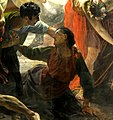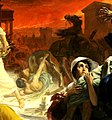The last day of Pompeii (painting)

The Last Day of Pompeii is a large-format history painting by the Russian painter Karl Pawlowitsch Brjullow from the years 1830 to 1833. It measures 456.5 × 651 cm and was painted with oil on canvas. The picture shows the eruption of Vesuvius on August 24th, 79 AD. Stylistically, it combines Russian classicism with French-style romanticism .
background
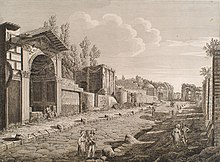
The city of Pompeii , which was buried in a volcanic eruption in AD 79, and the neighboring Herculaneum were the subject of intensive research and excavation activities in the early 19th century. The dramatic story of the town's fall also piqued the interest of artists. The English painter John Martin painted The Destruction of Pompeii and Herculaneum in 1822 and many graphics were created about the cities and the excavations.
In 1823 Brjullow traveled with his brother Alexander to Rome via Venice and Florence. Alexander Brjullow took part in the excavations and restoration of the thermal baths in Pompeii in 1825/26 and published the book Thermes de Pompéi in Paris in 1829 . Karl Brjullow probably first visited Pompeii in 1824. He also saw Alessandro Sanquirico's set design for Giovanni Pacini's opera L'ultimo giorno di Pompei ( The Last Day of Pompeii ; 1825), which was performed in Naples and at the Teatro alla Scala in Milan . He also visited the museum in Naples where the artifacts from Pompeii were exhibited. A visit to Pompeii in 1827 is definitely documented. He was so impressed by the Via dei Sepolcri that he decided to capture the events in a painting. Letters suggest that Brjullov had read the eyewitness account of Pliny the Younger and used it as a model for the painting.
In 1828, at the request of Countess Maria Razumowskaja , Brjullow made a first drawing of the events in Pompeii. The actual painting was commissioned by Prince Anatole Demidoff di San Donato , whom Brjullow met and portrayed in Naples. The painting was supposed to be completed in 1830, but by the end of the year the painter had just finished the outlines of the figures. He then traveled to Bologna and Venice and studied the works of Tintoretto and Titian .
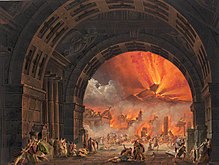
Content and composition
The subject of the picture is the eruption of Vesuvius in AD 79, during which the ancient Roman city of Pompeii was destroyed and most of the inhabitants died. It shows the fear and horror of the inhabitants during the volcanic eruption. Brjullow stated that he had studied Raphael's work The School of Athens (1509–1511) intensively and took it as a stylistic model. He said that he used classicist forms by the painters of the Renaissance , but that he combined them with the possibilities of romantic painting. He used a dramatic, lively color scheme, intense light-dark contrasts and emotionally charged image content. However, some sources also see an influence on Brjullow's Raphael's Der Borgobrand (1514-17) and Nicolas Poussin's The Plague of Ashdod (1630).
Brjullow renounced the coolness and lack of contrast and flatness of the prevailing classicism in favor of expression, lively colors and depth. The picture is rich in authentic details that Brullov discovered on his travels and studies. Drama and dynamism arise in the picture through the posture of the figures, but also through the threatening background with the cloudy sky, from which it rains ashes, and the statues falling from their pedestals. The figures and their poses are determined by fear and show stylistic features of ancient painting. Brjullow took this from the paintings of other artists such as Julia Samoilowa . The soldier and the boy rescuing an older man in the right foreground of the picture could be based on the story of Aeneas , who saved his father Anchises during the destruction of Troy. In the background of the picture the painter hid a portrait of himself as an ancient artist who carries his painting utensils with him on his head.
reception
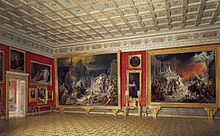
Brjullow worked on the painting for more than three years and his client Demidoff threatened to cancel the order. The work was shown for the first time in Brjullow's studio in Via San Claudio in Rome, where it immediately attracted attention. The son of writer Walter Scott is said to have studied it for hours and described it as "epic" and the classicist painter Vincenzo Camuccini praised it as a "flaming colossus". The Italian archaeologist Pietro Ercole Visconti praised the painter and his picture in an article. In Milan, Brjullow received a standing ovation and was carried through the streets with a flower garland. Edward Bulwer-Lytton , who published the novel The Last Days of Pompeii in 1834, also saw the picture in the city .
In 1834, The Last Day of Pompeii was shown in the Salon de Paris . The painting won a gold medal, but French criticism reacted cautiously. For some critics it was “out of date” compared to the also shown The Women of Algiers (1834) by Eugène Delacroix . A critic commented on the emotions depicted in the art magazine L'Artiste : “The impression has less to do with horror than with ridicule”.
The last day of Pompeii was the first Russian work of art to arouse greater interest outside of Russia, and it also made Bryullov known internationally. Five art academies made him an honorary member and the number of positive reviews and comments was so great that the Russian Society in Support of Artists put them in a book and had them translated into Russian.
In August 1834 the painting came to Russia and caused a similar enthusiasm there as in Italy. Brjullow was honored with the Order of St. Anna 3rd class. He also became a professor at the Imperial Art Academy. The Russian writer Ivan Sergeyevich Turgenev described the painting as “the glory of Russia and Italy” and it inspired Alexander Sergeyevich Pushkin to write a poem about the destruction of Pompeii. Russia saw the painting as the rise of Russian art in Europe and thus also of Russian artists. The writer Nikolai Wassiljewitsch Gogol said that the work was a “radiant resurrection of [Russian] painting that has remained in a semi-lethargic state for too long”. The Russian philosopher Alexander Ivanovich Herzen saw in the picture an allegory about the collapse of European monarchies or the tyrannical rule of the Russian Empire over the individual.
After the great success of The Last Day of Pompeii , other similar historical paintings were expected from Brjullov, but most of his attempts remained unfinished. Instead, he mainly focused on portraits of the Russian upper class and the tsarist family.
In 1968 and 1998 the painting was printed on a Soviet and a Russian postage stamp, respectively.
Provenance
The painting was created on behalf of Prince Demidoff for 25,000 rubles. In Russia, it was the first time in the Winter Palace of the Tsar I. Nicholas issued. In 1836 the Tsar donated it to the Imperial Art Academy . From 1851 it was exhibited in the Hermitage . It currently belongs to the collection of the Russian Museum in Saint Petersburg.
gallery
Countess Julia Samoilowa and Giovanni Pacini's daughters Giovannina and Amazilia are said to have been the model for this figurine .
Web links
Individual evidence
- ↑ Andrew Wallace-Hadrill, Joanne Berry: Pompeii exhibition: a timeline of Pompeii and Herculaneum , The Telegraph , March 3, 2013
- ↑ Galina Leontjewa: Karl Briullov: Artist of Russian Romanticism . Parkstone Aurora, Bournemouth 1996, p. 17
- ↑ a b c d e f g h i j k l m n o p q Rosalind P. Blakesley: The Russian Canvas: Painting in Imperial Russia, 1757–1881 . Yale University Press, New Haven 2016, pp. 143-149
- ↑ a b c d e f g Gardner Coates, Victoria C., Kenneth Lapatin and Jon L. Seydl: The Last Days of Pompeii: Decadence, Apocalypse, Resurrection . The J. Paul Getty Museum, Los Angeles 2012, pp. 140-143
- ^ A b George Heard Hamilton: The Art and Architecture of Russia . Penguin, Harmondsworth 1975, p. 253
- ↑ Leontjewa (1996), p. 30 f.
- ↑ Leontjewa (1996), p. 20.
- ^ Salon de 1834. Peinture . In: L'Artiste , Volume 7, No. 12 (1834), p. 13.
- ↑ Leontjewa (1996), p. 35
- ↑ Leontjewa (1996), p. 36
- ^ Catalog of postage stamps of the USSR . Central Philatelic Agency “Soyuspechat” of the Ministry of Communication of the USSR, 1983, p. 457
- ↑ Catalog of Postage Stamps of the Russian Federation 1998 . 1999, pp. 12/13
- ↑ Leontjewa, p. 30.
- ↑ Leontjewa, p. 33.





